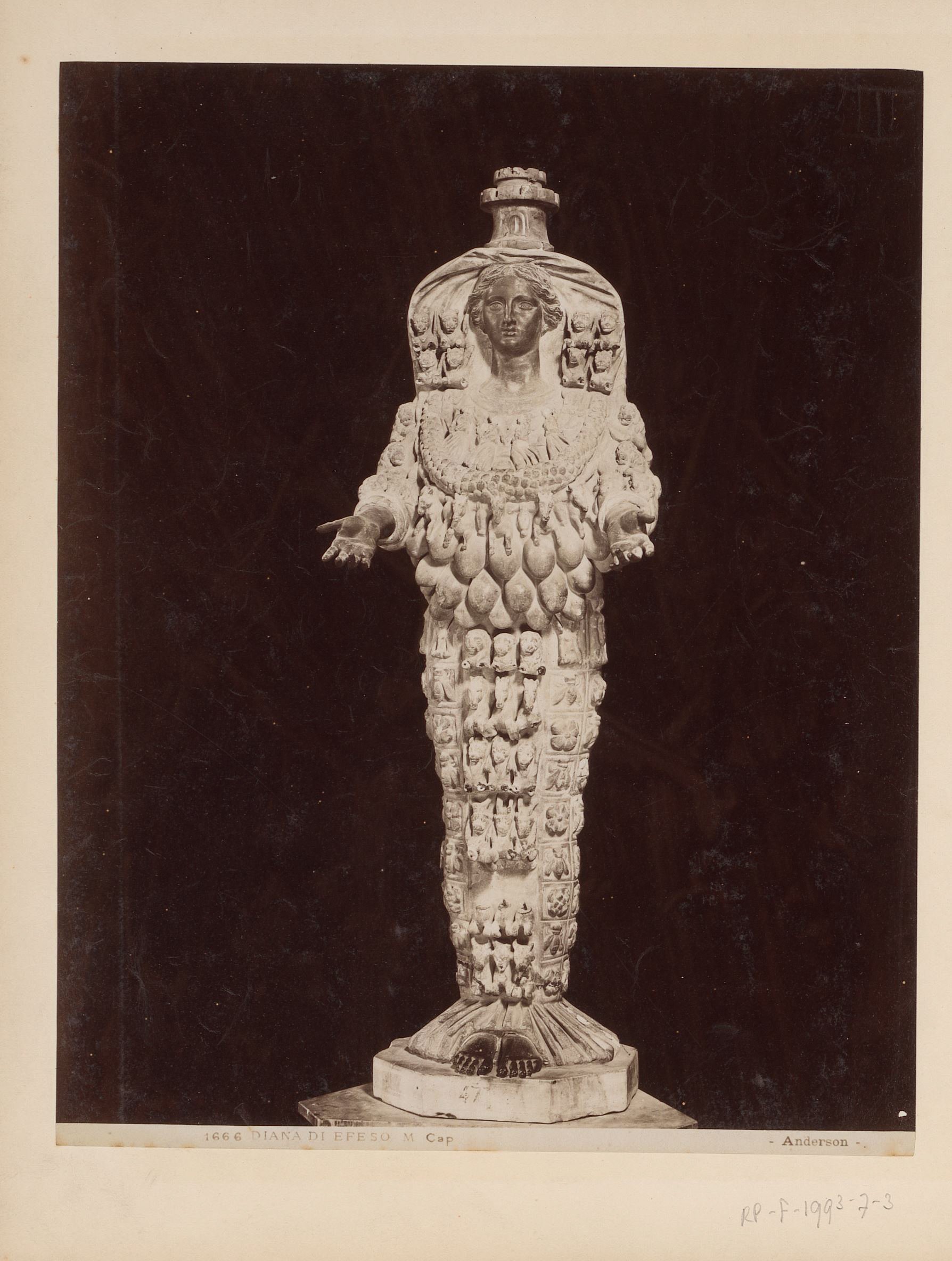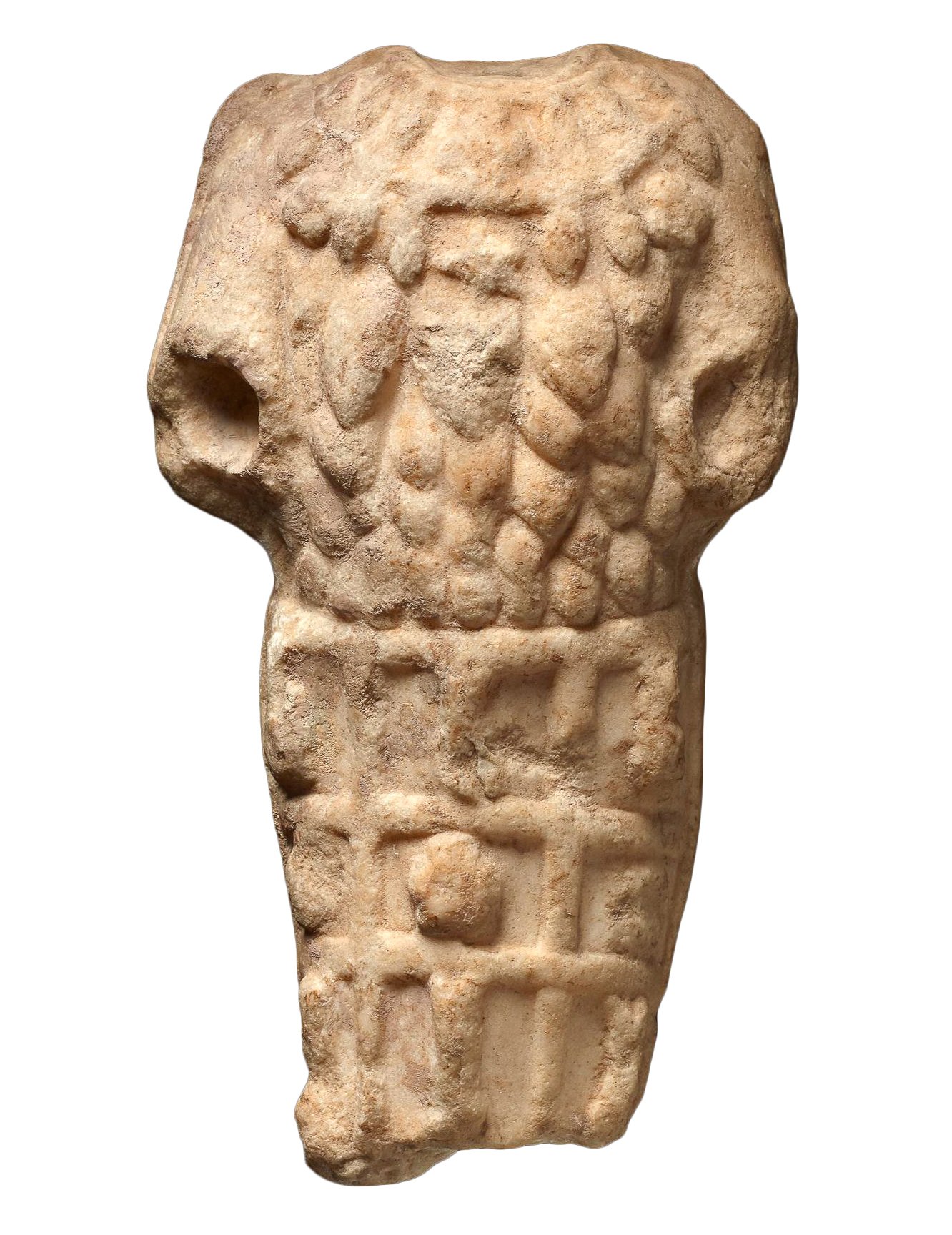BRIDE TO BE
Model posing in the celebrated cocoon wedding dress • Autumn / Winter 1965 Haute Couture Collection • Yves Saint Laurent • Fouli Elia • Image courtesy of Yves Saint Laurent : Images of Design 1958 - 1988 by Marguerite Duras
Yves Saint Laurent’s folkloric knit bridal gown that famously closed his 1965 Haute Couture collection and was later revived in his final 2002 Couture show, was known to be inspired by traditional Russian Matryoshka dolls. The visionary designer’s iconic reinterpretation of the traditional wedding dress however, shared a surprisingly appropriate resemblance to ancient statues depicting The Great Artemis of Ephesus, dating as far back as the Bronze Age…
Artemis, or Diana, in Asiatic and Hellenic Guise • 1924 • Ewing Galloway • Image courtesy of Period Paper
Presented in the couturier’s legendary Homage to Mondrian Collection, this wondrous hand-knit cocoon wedding gown adorned with ivory silk satin ribbons, derived its shape from Russian nesting dolls which date back to the 1890s… Curiously, these wooden nesting dolls are imbued with the symbolism of fertility and motherhood, similar to The Ephesian Artemis who was known as the “great mother goddess” and protector of pregnant women. Furthermore, the original statue of the Ephesian Artemis displayed in her temple, considered to be one of the seven wonders of the ancient world, was venerated in an archaic, pre-Hellenic cult image that was carved of wood (a xoanon), similar to the Russian figurines. Artemis' role as an ardent patron of female reproduction may be symbolized by the spherical objects that cover the lower part of her chest, but the common assumption that they are female breasts has been debunked. In actuality, they most likely represented the scrotal sacs of sacrificed bulls, or possibly decorative amber gourds rediscovered in archaeological excavations, which were known in Asia as fertility symbols for centuries. Also noteworthy, the body and legs of Artemis were enclosed within a tapering pillar-like figure, from which the goddess' feet protrude, just as in Monsieur Saint Laurent’s knit creation… The idea that a wedding gown is a historical symbol of future procreation only furthers the correlation between Saint Laurent’s modestly iconic wedding gown, Russia’s womb filled Matryoshkas and the relics depicting a maternal Artemis excavated throughout the former Roman Empire. • All Collages by Moi
Original sketch of Yves Saint Laurent’s 1965 wedding dress courtesy of Yves Saint Laurent Style atop a photograph depicting the 1956 discovery of the Statue of Artemis at the Temple of Artemis in Ephesus | Collage by Sarah Aaronson
Diana of Ephesus • Circa 1875 • Image courtesy of Manual of Mythology : Greek and Roman, Norse, and Old German, Hindoo and Egyptian Mythology by Alexander S. Murray via the New York Public Library
Statue of Artemis captured in the open-air archaeological museum • 1962 • Selçuk (formerly Ephesus) Turkey • Paolo Monti • Image courtesy of the Biblioteca Europea di Informazione e Cultura
Yves Saint Laurent wedding gown worn by Audrey Marnay • Spring / Summer 2002 Haute Couture Collection • January 22, 2002 • Centre Pompidou, Paris • Image courtesy of Guy Marineau via Musée Yves Saint Laurent, Paris
Diana of Ephesus featured in The Strange Vienna, or Monthly Conversations of Various Curiosities of Nature and Art Located There • Circa 1727 • Universitätsbibliothek, Heidelberg
Statue of the Ephesian Artemis • 2nd Century B.C. • Roman Period • The Israel Museum, Jerusalem
Diana of Ephesus • Circa 1514 - 1546 • Giulio Romano • The British Museum
Sheet of studies after the antique, including Diana the huntress and Diana of Ephesus • Circa 1593 - 1665 • Nicolas Poussin • The British Museum, London
Original sketch of the ivory cocoon wedding dress • Autumn / Winter 1965 Haute Couture Collection • Yves Saint Laurent • Image courtesy of Musée Yves Saint Laurent, Paris
The Ephesus Artemis • Circa 2nd Century A.D. • Galleria dei Candelabri, Museo Pio-Clementino, Vatican City
Original sketch of the Autumn / Winter 1965 Haute Couture bride, by Italian fashion reporter Brunetta (Bruna Mateldi Moretti) for Corriere della Sera • Image courtesy of YSL Lexicon : An ABC of the Fashion, Life, and Inspirations of Yves Saint Laurent by Martina Mondadori
Statue of Diana of Ephesus • Circa 1800 - 1810 • Victoria and Albert Museum, London
Statue of Artemis of Ephesus • Circa Second Half of the 2nd Century C.E. • Museo Archeologico Nazionale, Napoli • Image courtesy of Sergey Sosnovskiy
Sketch of a group of antiquities including a statue of Artemis of Ephesus • Circa 18th - 19th Century • The British Museum, London
Studies of Two Statues of Diana of Ephesus • Circa 1800 - 1820 • Victoria and Albert Museum, London
Colonie Italiane Libia postage stamp featuring Diana of Ephesus • Circa 1921 • Image courtesy of HipStamp
Statue of Artemis of Ephesus • Circa Second Half of the 2nd Century C.E. • Museo Archeologico Nazionale, Napoli
Diana of the Ephesians • Circa 1729 - 1804 • Pietro Antonio Novelli
Diana of Ephesus • Circa 1853 - 1876 • After a work by the workshop of Raphael • Image courtesy of the Prince Albert Collection via the Royal Collection Trust
Marble Statue of Artemis of Ephesus • Imperial Roman • Musée du Louvre, Paris
Sculpture of Artemis of Ephesus in the Capitoline Museums in Rome • Circa 1857 - 1875 • James Anderson • Rijksmuseum, Amsterdam
Torso from a miniature marble copy of the cult statue of the goddess Artemis of Ephesus • 2nd Century • Roman • The British Museum, London
Diana of Ephesus as Herme • Circa 1543 - 1545 • John Mignon • Rijksmuseum, Amsterdam
Fertility statue of Artemis of Ephesus • Circa 1787 - 1844 • Johann Christian Benjamin Gottschick • Rijksmuseum, Amsterdam
Maintenance and restoration of the celebrated 1965 cocoon wedding dress at the Musée Yves Saint Laurent, Paris
View of Ephesus with Temple and Statue • The temple of the goddess Diana (Artemis) is depicted in a frame at the bottom left and a statue of Diana at the bottom right. The Temple of Diana in Ephesus is one of the wonders of the world • Circa 1725 - 1727 • Rijksmuseum, Amsterdam
Marble headless Statue of Artemis captured in the open-air archaeological museum • 1962 • Selçuk (formerly Ephesus) Turkey • Paolo Monti • Image courtesy of the Biblioteca Europea di Informazione e Cultura
Maintenance and restoration of the celebrated 1965 cocoon wedding dress at the Musée Yves Saint Laurent, Paris
Torso from a miniature marble copy of the cult statue of the goddess Artemis of Ephesus • 2nd Century • Roman • The British Museum, London
Model posing in the celebrated cocoon wedding dress • Autumn / Winter 1965 Haute Couture Collection • Yves Saint Laurent • Giancarlo Botti
Colonie Italiane Libia postage stamp featuring Diana of Ephesus • Circa 1924 - 40 • Image courtesy of Big Blue 1840 - 1940
The Ephesus Artemis • Circa 2nd Century A.D. • Galleria dei Candelabri, Museo Pio-Clementino, Vatican City







































